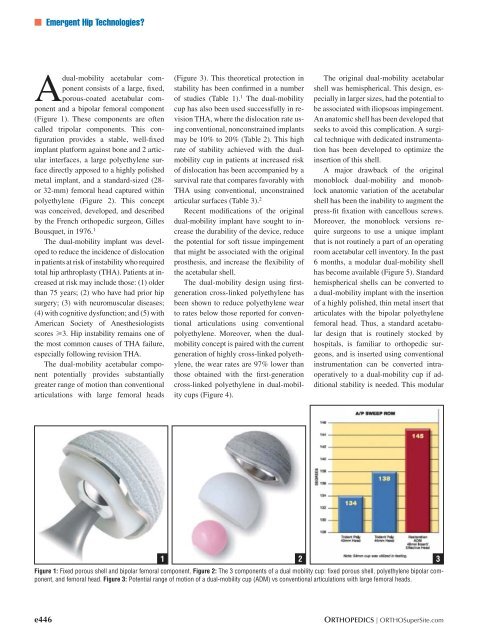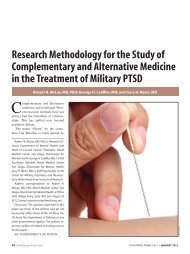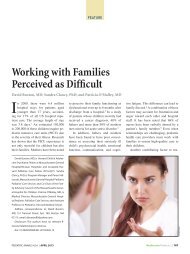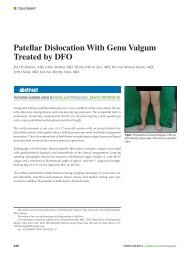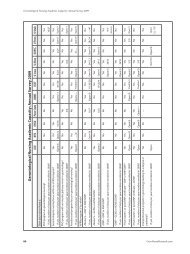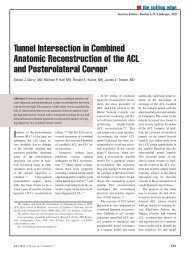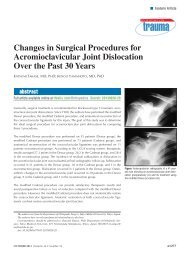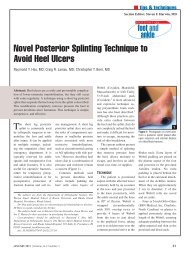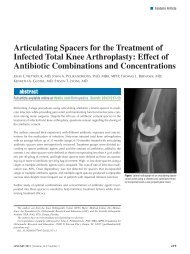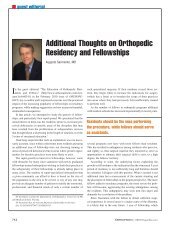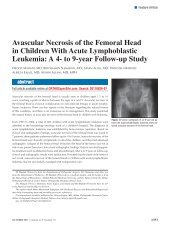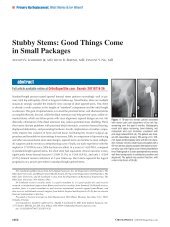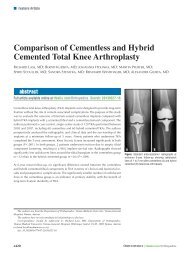Dual Poly Liner Mobility Optimizes Wear and Stability in THA - Healio
Dual Poly Liner Mobility Optimizes Wear and Stability in THA - Healio
Dual Poly Liner Mobility Optimizes Wear and Stability in THA - Healio
You also want an ePaper? Increase the reach of your titles
YUMPU automatically turns print PDFs into web optimized ePapers that Google loves.
■ Emergent Hip Technologies?<br />
A<br />
dual-mobility acetabular component<br />
consists of a large, fixed,<br />
porous-coated acetabular component<br />
<strong>and</strong> a bipolar femoral component<br />
(Figure 1). These components are often<br />
called tripolar components. This configuration<br />
provides a stable, well-fixed<br />
implant platform aga<strong>in</strong>st bone <strong>and</strong> 2 articular<br />
<strong>in</strong>terfaces, a large polyethylene surface<br />
directly apposed to a highly polished<br />
metal implant, <strong>and</strong> a st<strong>and</strong>ard-sized (28-<br />
or 32-mm) femoral head captured with<strong>in</strong><br />
polyethylene (Figure 2). This concept<br />
was conceived, developed, <strong>and</strong> described<br />
by the French orthopedic surgeon, Gilles<br />
Bousquet, <strong>in</strong> 1976. 1<br />
The dual-mobility implant was developed<br />
to reduce the <strong>in</strong>cidence of dislocation<br />
<strong>in</strong> patients at risk of <strong>in</strong>stability who required<br />
total hip arthroplasty (<strong>THA</strong>). Patients at <strong>in</strong>creased<br />
at risk may <strong>in</strong>clude those: (1) older<br />
than 75 years; (2) who have had prior hip<br />
surgery; (3) with neuromuscular diseases;<br />
(4) with cognitive dysfunction; <strong>and</strong> (5) with<br />
American Society of Anesthesiologists<br />
scores 3. Hip <strong>in</strong>stability rema<strong>in</strong>s one of<br />
the most common causes of <strong>THA</strong> failure,<br />
especially follow<strong>in</strong>g revision <strong>THA</strong>.<br />
The dual-mobility acetabular component<br />
potentially provides substantially<br />
greater range of motion than conventional<br />
articulations with large femoral heads<br />
(Figure 3). This theoretical protection <strong>in</strong><br />
stability has been confirmed <strong>in</strong> a number<br />
of studies (Table 1). 1 The dual-mobility<br />
cup has also been used successfully <strong>in</strong> revision<br />
<strong>THA</strong>, where the dislocation rate us<strong>in</strong>g<br />
conventional, nonconstra<strong>in</strong>ed implants<br />
may be 10% to 20% (Table 2). This high<br />
rate of stability achieved with the dualmobility<br />
cup <strong>in</strong> patients at <strong>in</strong>creased risk<br />
of dislocation has been accompanied by a<br />
survival rate that compares favorably with<br />
<strong>THA</strong> us<strong>in</strong>g conventional, unconstra<strong>in</strong>ed<br />
articular surfaces (Table 3). 2<br />
Recent modifications of the orig<strong>in</strong>al<br />
dual-mobility implant have sought to <strong>in</strong>crease<br />
the durability of the device, reduce<br />
the potential for soft tissue imp<strong>in</strong>gement<br />
that might be associated with the orig<strong>in</strong>al<br />
prosthesis, <strong>and</strong> <strong>in</strong>crease the flexibility of<br />
the acetabular shell.<br />
The dual-mobility design us<strong>in</strong>g firstgeneration<br />
cross-l<strong>in</strong>ked polyethylene has<br />
been shown to reduce polyethylene wear<br />
to rates below those reported for conventional<br />
articulations us<strong>in</strong>g conventional<br />
polyethylene. Moreover, when the dualmobility<br />
concept is paired with the current<br />
generation of highly cross-l<strong>in</strong>ked polyethylene,<br />
the wear rates are 97% lower than<br />
those obta<strong>in</strong>ed with the first-generation<br />
cross-l<strong>in</strong>ked polyethylene <strong>in</strong> dual-mobility<br />
cups (Figure 4).<br />
The orig<strong>in</strong>al dual-mobility acetabular<br />
shell was hemispherical. This design, especially<br />
<strong>in</strong> larger sizes, had the potential to<br />
be associated with iliopsoas imp<strong>in</strong>gement.<br />
An anatomic shell has been developed that<br />
seeks to avoid this complication. A surgical<br />
technique with dedicated <strong>in</strong>strumentation<br />
has been developed to optimize the<br />
<strong>in</strong>sertion of this shell.<br />
A major drawback of the orig<strong>in</strong>al<br />
monoblock dual-mobility <strong>and</strong> monoblock<br />
anatomic variation of the acetabular<br />
shell has been the <strong>in</strong>ability to augment the<br />
press-fit fixation with cancellous screws.<br />
Moreover, the monoblock versions require<br />
surgeons to use a unique implant<br />
that is not rout<strong>in</strong>ely a part of an operat<strong>in</strong>g<br />
room acetabular cell <strong>in</strong>ventory. In the past<br />
6 months, a modular dual-mobility shell<br />
has become available (Figure 5). St<strong>and</strong>ard<br />
hemispherical shells can be converted to<br />
a dual-mobility implant with the <strong>in</strong>sertion<br />
of a highly polished, th<strong>in</strong> metal <strong>in</strong>sert that<br />
articulates with the bipolar polyethylene<br />
femoral head. Thus, a st<strong>and</strong>ard acetabular<br />
design that is rout<strong>in</strong>ely stocked by<br />
hospitals, is familiar to orthopedic surgeons,<br />
<strong>and</strong> is <strong>in</strong>serted us<strong>in</strong>g conventional<br />
<strong>in</strong>strumentation can be converted <strong>in</strong>traoperatively<br />
to a dual-mobility cup if additional<br />
stability is needed. This modular<br />
1<br />
2<br />
3<br />
Figure 1: Fixed porous shell <strong>and</strong> bipolar femoral component. Figure 2: The 3 components of a dual mobility cup: fi xed porous shell, polyethylene bipolar component,<br />
<strong>and</strong> femoral head. Figure 3: Potential range of motion of a dual-mobility cup (ADM) vs conventional articulations with large femoral heads.<br />
e446<br />
ORTHOPEDICS | ORTHOSuperSite.com


